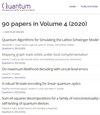低开销Qutrit魔法状态蒸馏
IF 5.1
2区 物理与天体物理
Q1 PHYSICS, MULTIDISCIPLINARY
引用次数: 0
摘要
我们表明,使用量子位而不是量子位可以大幅降低与容错量子计算方法(称为神奇状态蒸馏)相关的开销成本。我们建立了一个家庭 $[[9m-k, k, 2]]_3$ 任意正整数的三正交四元纠错码 $m$ 和 $k$ 有 $k \leq 3m-2$ 这些都适合魔力状态蒸馏。在魔法状态蒸馏中,产生具有目标错误率的魔法状态所需的辅助装置的数量 $\epsilon$ 是 $O(\log^\gamma \epsilon^{-1})$,其中为屈服参数 $\gamma$ 表征间接成本。因为 $k=3m-2$,我们的代码有 $\gamma = \log_2 (2+\frac{6}{3 m-2})$,这倾向于 $1$ as $m \to \infty$。此外, $[[20,7,2]]_3$ 从构造中产生的Qutrit代码 $m=3$ 已经有一个yield参数为 $1.51$ 它比所有已知的小于几百个量子比特的量子比特三正交码都要好。本文章由计算机程序翻译,如有差异,请以英文原文为准。
Low Overhead Qutrit Magic State Distillation
We show that using qutrits rather than qubits leads to a substantial reduction in the overhead cost associated with an approach to fault-tolerant quantum computing known as magic state distillation. We construct a family of $[[9m-k, k, 2]]_3$ triorthogonal qutrit error-correcting codes for any positive integers $m$ and $k$ with $k \leq 3m-2$ that are suitable for magic state distillation. In magic state distillation, the number of ancillae required to produce a magic state with target error rate $\epsilon$ is $O(\log^\gamma \epsilon^{-1})$, where the yield parameter $\gamma$ characterizes the overhead cost. For $k=3m-2$, our codes have $\gamma = \log_2 (2+\frac{6}{3 m-2})$, which tends to $1$ as $m \to \infty$. Moreover, the $[[20,7,2]]_3$ qutrit code that arises from our construction when $m=3$ already has a yield parameter of $1.51$ which outperforms all known qubit triorthogonal codes of size less than a few hundred qubits.
求助全文
通过发布文献求助,成功后即可免费获取论文全文。
去求助
来源期刊

Quantum
Physics and Astronomy-Physics and Astronomy (miscellaneous)
CiteScore
9.20
自引率
10.90%
发文量
241
审稿时长
16 weeks
期刊介绍:
Quantum is an open-access peer-reviewed journal for quantum science and related fields. Quantum is non-profit and community-run: an effort by researchers and for researchers to make science more open and publishing more transparent and efficient.
 求助内容:
求助内容: 应助结果提醒方式:
应助结果提醒方式:


